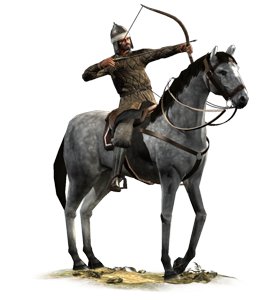Difference between revisions of "Zamindari Horsemen (ETW Unit)"
Tango12345 (talk | contribs) m (Removed category "Empire Total War Units"; Quick-adding category "ETW Units" (using HotCat)) |
|||
| (8 intermediate revisions by 3 users not shown) | |||
| Line 1: | Line 1: | ||
| − | + | {{TW Unit|image=[[Image:Zamindari_Horsemen.jpg]] | |
| + | |Class=Missile Cavalry | ||
| + | |Unit Size=60 men | ||
| + | |Weaponry=Bows, Sabres | ||
| + | |Region=Global | ||
| + | |Recruitment Cost=890 | ||
| + | |Upkeep Cost=260 | ||
| + | |Building Requirements=Barracks | ||
| + | |Tech Requirements=None | ||
| + | |Attributes= | ||
| + | <li>Can skirmish</li> | ||
| + | <li>Can Guard</li> | ||
| + | <li>Can hide in woodland</li> | ||
| + | <li>Can Fire from Horseback</li> | ||
| + | <li>Good stamina</li> | ||
| + | <li>Resistant to heat fatigue</li> | ||
| − | + | }} | |
| − | |||
| − | |||
| − | |||
| − | |||
| − | + | [[Image:Zamindari_Horsemen_thumb.png]]These "feudal" troops are armed in traditional style and, while cheap, may not be as reliable as regular forces. | |
| − | + | ==Overview== | |
| − | |||
| − | |||
| − | |||
| − | |||
| − | |||
| − | |||
| − | |||
| − | |||
| − | |||
| − | |||
| − | |||
| − | |||
| − | |||
| − | |||
| − | + | The zamindars, or landholders, recruit troops from among the peasantry farming the lands they manage. A life in the ranks is somewhat better than one toiling in the fields and offers the chance of loot and excitement. | |
| − | |||
| − | |||
| − | |||
| − | |||
| − | |||
| − | + | At first sight, the zamindar system has much in common with the medieval "feudal" idea, and this was how many Europeans saw the system. A zamindar would be given land to run as a tax farm, squeezing the peasants for all the revenue he could get. At the same time, the zamindari would have a place in a formal hierarchy and were expected to contribute a contingent of troops to the army. This sounds like the feudal idea of providing men to an overlord, but it was based on financial, not fealty, principles. There were even landholders who were expected to supply elephant troops rather than cavalry and footmen. When the European trading companies took over tax collection, they often left the local landholders to collect taxes after weeding out the most glaringly corrupt. | |
| − | + | ==Details== | |
| − | + | Horse archers should be used to harass the enemy from a distance and should generally avoid engaging in melee, and the Zamindari Horsemen are no exception. They are vulnerable to artillery and heavy cavalry. | |
==Factions== | ==Factions== | ||
| − | *[[Image:Mughal_flag.jpg|25px]] [[Mughal (ETW Faction) | Mughal]] | + | *[[Image:Mughal_flag.jpg|25px]] [[Mughal Empire (ETW Faction) | Mughal Empire]] |
*[[Image:Mysore_flag.jpg|25px]] [[Mysore (ETW Faction) |Mysore]] | *[[Image:Mysore_flag.jpg|25px]] [[Mysore (ETW Faction) |Mysore]] | ||
| − | *[[Image:Persia_flag.jpg|25px]] [[ | + | *[[Image:Persia_flag.jpg|25px]] [[Persia (ETW Faction) | Persia]] |
*[[Image:Afghanistan.jpg|25px]] [[Afghanistan (ETW Faction) |Afghanistan]] | *[[Image:Afghanistan.jpg|25px]] [[Afghanistan (ETW Faction) |Afghanistan]] | ||
| − | *[[Image:Khante_khiva.jpg|25px]] [[ | + | *[[Image:Khante_khiva.jpg|25px]] [[Khanate of Khiva (ETW Faction) |Khanate of Khiva]] |
| − | [[Category: | + | [[Category:ETW Cavalry]] |
| + | [[Category:ETW Units]] | ||
Latest revision as of 09:51, 30 May 2017
 These "feudal" troops are armed in traditional style and, while cheap, may not be as reliable as regular forces.
These "feudal" troops are armed in traditional style and, while cheap, may not be as reliable as regular forces.
Overview
The zamindars, or landholders, recruit troops from among the peasantry farming the lands they manage. A life in the ranks is somewhat better than one toiling in the fields and offers the chance of loot and excitement.
At first sight, the zamindar system has much in common with the medieval "feudal" idea, and this was how many Europeans saw the system. A zamindar would be given land to run as a tax farm, squeezing the peasants for all the revenue he could get. At the same time, the zamindari would have a place in a formal hierarchy and were expected to contribute a contingent of troops to the army. This sounds like the feudal idea of providing men to an overlord, but it was based on financial, not fealty, principles. There were even landholders who were expected to supply elephant troops rather than cavalry and footmen. When the European trading companies took over tax collection, they often left the local landholders to collect taxes after weeding out the most glaringly corrupt.
Details
Horse archers should be used to harass the enemy from a distance and should generally avoid engaging in melee, and the Zamindari Horsemen are no exception. They are vulnerable to artillery and heavy cavalry.
